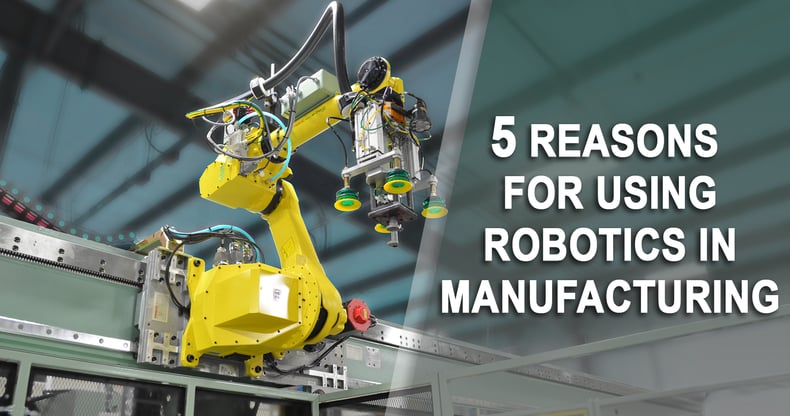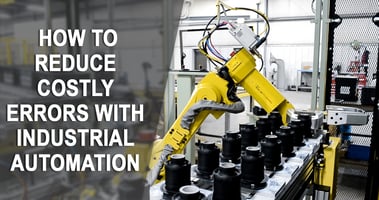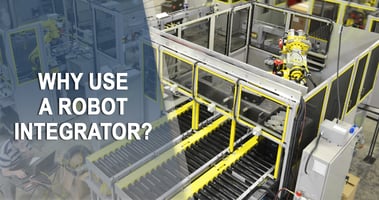The International Federation of Robotics (IFR) estimates that just three years ago, there were...
5 Reasons for Using Robotics in Manufacturing

A shift in manufacturing continues to unfold as a result of COVID-19, and many companies are turning to robotics as a solution for providing safe workspaces and adhering to social distancing guidelines.
The benefits of robotics to manufacturing facilities are far-reaching, even beyond COVID. Minimizing the risk to employees during the current pandemic is critical, but there are several other safety concerns that robots in manufacturing address. Increased flexibility, reliability, productivity, and cost savings are all also compelling advantages of leveraging robotics in manufacturing.
1. Safety
Hazards such as the heat from a solder pot or the weight of an engine block manifest safety concerns for human operators, and manufacturing operations like these are obvious victories for automation. But what about the not-so-obvious vulnerabilities? Workplace injuries are a liability nightmare, so it is important to consider every potential source of harm within an operation that includes human workers.
Collaborative robots present a resolution for circumstances where human intervention within an operation is unavoidable. A collaborative solution allows humans and robots to safely work in tandem. Unfortunately, the robot label of “collaborative” does not automatically translate to “safe”.
A robotic solution may be deployed to address safety concerns, but the work cell itself presents its own safety challenges. Ancillary equipment must be harmless, pinch points require evaluation, and several other factors must be considered.
The RIA (Robotic Industries Association) requires a formal risk assessment (RA) of every robotic system. An effective risk assessment to design a safe machine requires experience. Safety standards are updated regularly, and a trustworthy integrator frequently renews their education on the guidelines.
2. Flexibility
While dedicated machinery has its place, a major benefit of using robots in manufacturing is flexibility. The positioning of a robot is agile based on its Degrees of Freedom (DOF), which grant manipulation potential far greater than rigid automation.
The ability to redeploy a robot to perform a different job creates an amenable solution that most manufacturers can profit from. What’s more, robots can be easily resold if they are no longer needed.
3. Reliability
“Performing consistently well” is one definition of the word reliability. Traditionally, manufacturers rely on human operators to complete tasks within the manufacturing process. Human operators experience fatigue that leads to production consistency declines, while illness and shift breaks interrupt output. Human nature will always persist, but robotics in manufacturing diminish the pains experienced by the unreliability of human operators.
There is little doubt that robots outperform human operators when it comes to reliability, but what about hard automation? Consider the number of sensors, valves, and other hardware that is required within a piece of dedicated machinery. Robots require far less in comparison which translates to fewer failure points.
4. Productivity
Equipment downtime, quality issues, and operator breaks are unavoidable variables that cause deterioration of productivity. Automation significantly reduces and nearly eliminates these and other variables to improve output. Additionally, automation can operate three shifts per day, seven days per week, and fifty-two weeks per year without fatigue, only pausing for changeover and regular maintenance.
Eliminating negative impacts on productivity caused by human operators is noteworthy, but automation’s speed and accuracy is equally advantageous. Shorter cycle times are typical, and the removal of errors - both equipment and part errors - translates to a higher quantity of parts produced.
5. Cost
The savings of robotics in manufacturing resulting from safety, flexibility, reliability, and productivity are glaring, but it’s important to consider all of the contributors to the True Cost of Ownership (TCO). While the initial investment in robotic integration may exceed other solutions, it is important to consider the following benefits and analyze how they dilute the cost:
- Productivity and Overall Equipment Efficiency (OEE)
- Machine utilization
- Ergonomic savings
- Labor reduction
- Worker retention
- Quality improvements
For additional information on TCO, check out our blog, “How to Determine the True Cost of Robotics Integration at your Organization.”
Conclusion
Reduction in safety concerns, added flexibility, reliability, productivity, and cost savings are just scratching the metaphorical surface of reasons to use robotics in manufacturing. As competitors are investing in robotics, it’s going to become critical to implement robotics as a way to keep up. The divergence between those that embrace automation and those that don’t is more obvious today than ever before.



